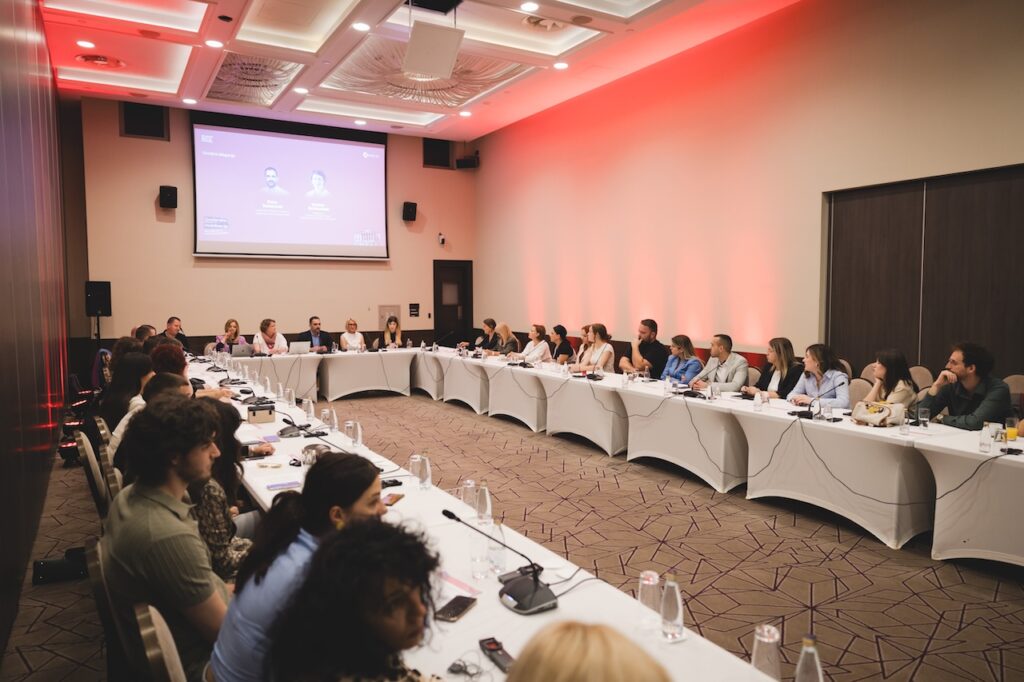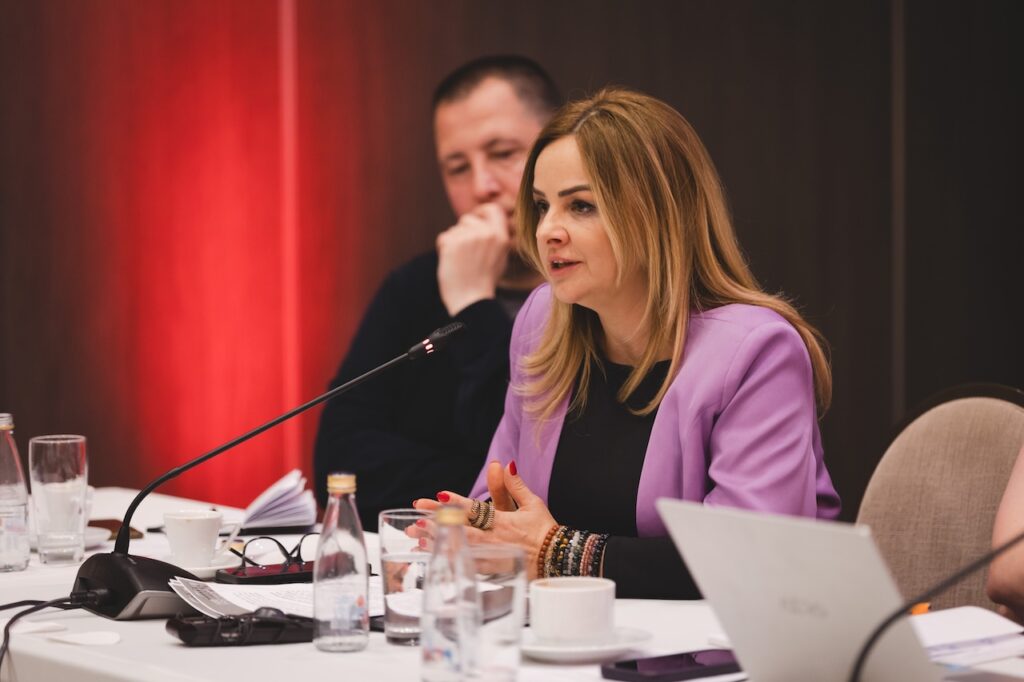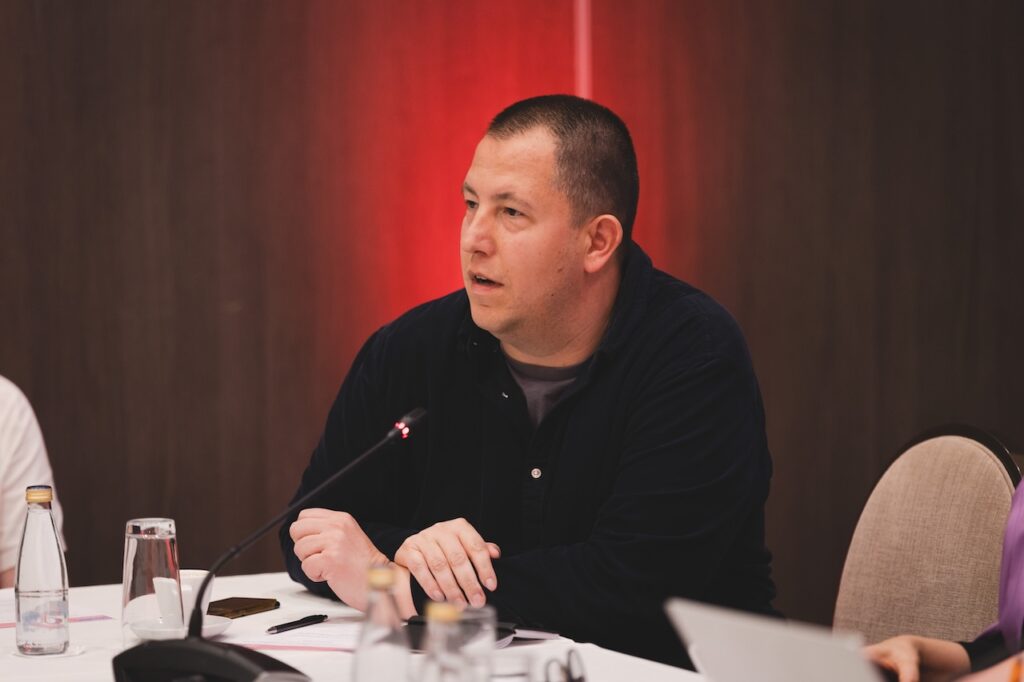In Montenegro, protest culture is still in the making, and it is developing painfully slowly, especially when it comes to protests with a civic and progressive character, said Daliborka Uljarević, Executive Director of the Centre for Civic Education (CCE), during the conference Civic Mobilization as a Response to Institutional Deficit, organized today by CCE and the Friedrich Ebert Stiftung (FES).
Uljarević expressed her encouragement by developments in the region, despite all differences in structure and achievements so far, noting that this is also a success of civil society, which has been working for decades to empower citizens to demand that institutions operate in the public interest, not in the interest of political parties or private groups.
“When it comes to Montenegro, the case of the informal student movement ‘Kamo śutra’ is unique in that it managed, from a relatively small base, to transform into a mobilized resistance to institutional cynicism and a security collapse“, Uljarević said, adding that, as expected, this was followed by pressure, labeling, attempts at discreditation, and targeting.
The movement Kamo śutra, she emphasized, emerged as a symbol of hope and inspiration, a testament that young people, who are often underestimated in Montenegrin society, can initiate meaningful processes. Today, it stands as a reminder that grassroots pressure does carry weight and can be powerful, but also that it must be preserved, expanded, and protected from being silenced by fear or apathy.
“Protest culture in Montenegro is still developing, and it’s a painstaking process—especially with protests that have a civic, progressive character”, said Uljarević. She added that what is happening now in Serbia didn’t happen overnight either. “There were many large protests before the situation matured to what it is today”, Uljarević noted. She emphasized that the protests of Kamo śutra should be viewed as a symptom, an indicator, and a symbol of a deeper process within Montenegrin society—one that already demonstrates that the citizens are, in many ways, more mature than those who are supposed to lead them and make decisions on their behalf.
That movement, Uljarević said, emerged out of an authentic need to react to injustice, and its initiators did not demand anything radical. She assessed that their demands were very reasonable and added that in a different political reality, even the government itself would promote those demands as part of a reform agenda. “Instead of a responsible response, they were met with panic, defensiveness, and eventually an offensive attack, characterized by partisan limitations and a clear disconnect between top government officials and the public”, Uljarević said.
She reminded that MNE Pulse, a survey conducted in February by CCE and DAMAR, showed that only 35.8% of citizens believe Montenegro is moving in the right direction, which is a significant drop compared to the previous year. During the same period, nearly half of the population (49.3%) described the situation in the country as negative or unstable, with concern being the dominant sentiment.
“When you add to that the fact that 56.7% of citizens believe someone should be held accountable for the events of January 1 on Cetinje, we get a picture of a society where the demand for accountability has become a widespread, cross-party sentiment. Kamo śutra was effectively a catalyst for that sentiment”, said Uljarević. She added that the movement achieved high visibility: 86% of citizens had heard of it, 17.4% had participated in it, and 61.1% supported its demands. She emphasized that these are “important numbers, even in a regional context, for any youth-led movement—especially one without a political or, in our context, religious infrastructure”.
According to Uljarević, the significance of these protests is not necessarily in whether they achieved concrete results – they broke through apathy and proved that active social potential exists, and that is an investment for the future.
She stated that this year’s protests in Montenegro, particularly in the first quarter, as well as those related to agreements with the United Arab Emirates, convey three key messages: “that institutions without trust are politically hollow and cannot be saved by PR, only by proven accountability; that generational voices can be disruptive but also constructive, if given space and support; and that civic pressure is not a whim, but a corrective mechanism of democracy”.
As Uljarević pointed out, the key question today is not why Kamo śutra disbanded, but whether society will find new ways to apply democratic pressure in order to hold the government accountable. “The answer doesn’t lie with the institutions—they’ve already shown where they stand. The answer depends on all of us: whether we will stay silent or take action”, Uljarević concluded.
Dušan Spasojević, a professor at the Faculty of Political Sciences at the University of Belgrade, said that what is happening in Serbia now “did not come out of nowhere and is not without roots”.
“From the perspective of institutional deficit, these protests can be understood in the context of what happened after the mass shooting at the Vladislav Ribnikar Elementary School and in Mladenovac”, Spasojević said, adding that there was no institutional response, as only one minister, Branko Ružić, resigned, and the investigative committee formed in the Serbian parliament was later dissolved.
“When the awning collapsed in Novi Sad, and (Aleksandar) Vučić and others started explaining how everything had been renovated except the awning, public anger spilled into the streets”, Spasojević added.
He noted that the model of plenums as forms of direct democracy have been used in Serbia before, but not with this kind of longevity. He emphasized that the Serbian protests are characterized by a deliberate absence of visible leadership.
“Students are insistent that those familiar to the public should not be at the forefront”, Spasojević explained. That doesn’t mean there aren’t influential individuals in the plenum, but that their presence is highly balanced.
He also noted a growing distancing in the protests, initially just from political parties, but later from everything. “This distancing was later criticized. Students built a wall around themselves in an attempt to preserve the authenticity of their revolt and to distance themselves from all others”, he said.
Speaking about the future of protests in Serbia, Spasojević suggested the possibility of a “Montenegrin scenario”.
“What do I mean by that? I mean that once the Serbian Progressive Party falls, there will be a complete change in the political landscape, and new actors will emerge – though it’s hard to predict what they will be like”, Spasojević said.
He expressed optimism that this could create space for liberal, pro-European, and civic ideas to become stronger than they are today.
Irena Cvetković, a researcher from North Macedonia, said that protests in her country did not begin with the nightclub tragedy in Kočani, in which 62 young people died and over 200 were injured, but with the killing of a young woman, Frosina Kulakova, who was run over while crossing a pedestrian walkway. After the Kočani tragedy, Cvetković said, people began to ask, “Who’s next?”
She explained that the “Colorful Revolution”, a protest against the then-ruling government in North Macedonia, was creative, loud, and even fun in some ways, but it also had a very clear role.
Cvetković noted that they believed in transformation and that the focus was on bringing down the then-government. “What’s different now is that this felt more like a funeral than a protest – people walked in silence, holding candles”, she said.
Responding to audience questions, she stated that she doesn’t believe the protests in North Macedonia will lead to a change in government, but that they will shake the illusion that everything in the country is fine.
“We mourn, but we also demand accountability. We want to know who is responsible and how this happened”, Cvetković emphasized.
She concluded that, unfortunately, “only tragedies bring us to the streets, and that says a lot about the state of our societies”.
Petar Đukanović, Program Director of CCE, argued that in the region, especially in Montenegro, Serbia, and North Macedonia, political parties do not strengthen institutions but rather use them for their own goals. “Instead of vision, capacity, and responsibility, populism dominates, and institutions become hubs for corruption and influence trading, something that is now visibly costing human lives”, Đukanović said.
He stressed that protest is a vital form of civic mobilization that seeks to correct imbalances in power and remind authorities that legitimacy does not come solely from the ballot box, but also from day-to-day accountability to the public. Therefore, he emphasized, civic mobilization may today represent the last line of defense against the disintegration of public trust.
According to Đukanović, active citizens face intimidation campaigns, discreditation, and accusations, including narratives that link protesters and critics to foreign services or criminal organizations. “We are also witnessing the misuse of public resources to suppress civic mobilization, as well as efforts to portray it as a threat, rather than a step toward healing the state”, he said.
Đukanović concluded that civic mobilization remains one of the few mechanisms for power correction and for preserving public, professional, and accountable institutions, but it must not be purely reactive. “It has to be a permanent value, embedded in political culture, encouraged through the education system, and supported by public policies that see citizens as active participants in social life, not as passive observers”, he said.
Kirsten Schönefeld, Director of the Regional Office of the Friedrich Ebert Foundation in Belgrade, stressed the importance of the conference theme, noting that it points not only to institutional deficits but also to broader changes in democratic structures, both in the region and beyond.
“Today we have experts who analyzed this topic in Serbia, Montenegro, and North Macedonia. From today’s discussions, we will produce a publication to be released in June”, Schönefeld announced.
She said they aim to understand what lies behind these processes, what people – especially young people – are demanding, and whether this is about institutional deficit or a crisis of representative democracy. “Perhaps there is a need for new forms of democracy, for direct citizen participation in democracy, and for a new political culture”, Schönefeld concluded.
MINA Agency






